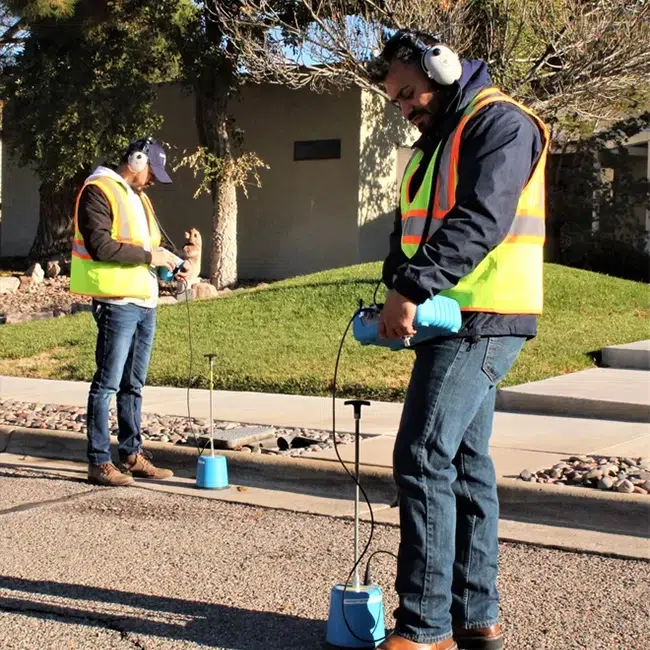Water Leak Detection: Just How to Recognize and Deal With Leaks Prior To They Trigger Damages
Ingenious Solutions for Early Detection of Water Leaks in Structures and Framework
From innovative leakage discovery modern technologies to the deployment of IoT sensors for real-time tracking, the landscape of leak avoidance is advancing rapidly. Automated water flow analysis systems are reshaping how leaks are identified and dealt with, paving the means for an aggressive strategy to water leakage discovery.
Advanced Leakage Discovery Technologies
Advanced leakage discovery innovations, outfitted with sophisticated sensing units and formulas, play a vital duty in quickly recognizing and determining water leakages in numerous setups. These modern technologies use a mix of acoustic, thermal, and electro-magnetic picking up techniques to identify leakages precisely. Acoustic sensors discover the noise of getting away water, enabling specific localization of the leakage resource. Thermal imaging identifies temperature level modifications triggered by water leakage, offering one more reliable method for leak identification. Electromagnetic sensing units can recognize adjustments in magnetic fields triggered by water, supplying yet an additional layer of leak detection ability.

IoT Sensors for Real-Time Monitoring
In the realm of modern-day water leakage detection, the assimilation of IoT sensing units for real-time tracking stands for a pivotal improvement in boosting proactive leak discovery capabilities. These sensors supply constant surveillance of water systems, giving real-time data on water circulation rates, stress variants, and temperature adjustments. By leveraging IoT technology, these sensing units can identify also the smallest anomalies in water use patterns, making it possible for early identification of prospective leakages prior to they escalate right into significant problems.
IoT sensors transfer information to a central platform, where advanced algorithms evaluate the info and produce informs or notices when abnormalities are detected. This real-time surveillance capacity permits homeowner or center managers to quickly address leakages, decreasing water damages, minimizing repair work costs, and preserving water sources.
Moreover, IoT sensors can be incorporated with structure administration systems, permitting computerized feedbacks to found leaks, such as turning off water shutoffs or triggering pumps to mitigate the influence of leakages. In general, the execution of IoT sensing units for real-time monitoring significantly boosts the effectiveness and effectiveness of water leakage detection in structures and framework.
Equipment Discovering Algorithms for Leak Prediction

One key advantage of making use of artificial try this out intelligence for leakage forecast is its ability to continually find out and enhance its accuracy with time. As more information is gathered and fed into the formula, it can fine-tune its predictions and adapt to transforming conditions, inevitably boosting the reliability of leak discovery systems.
Furthermore, artificial intelligence formulas can assist in identifying refined signs of leakages that may go unnoticed by typical tracking methods. water leak detection. By analyzing intricate data collections in real-time, these formulas can offer very early cautions and alerts, permitting punctual intervention and preventive upkeep to reduce potential water damages and associated prices
Using Thermal Imaging for Leakage Detection
Thermal imaging technology provides an appealing strategy for spotting water leaks in different systems and facilities. By using infrared radiation and temperature variations, thermal imaging cams can recognize surprise leakages that are not quickly noticeable to the naked eye.
One of the key benefits of thermal imaging for leakage detection is its non-intrusive nature. In general, the usage of thermal imaging innovation enhances the performance and precision of water leakage detection, making it a beneficial tool for maintaining the integrity of structures and facilities.
Automated Water Flow Evaluation Solutions
How can computerized water circulation evaluation systems revolutionize the detection and administration of leaks in numerous systems and frameworks? Automated water circulation evaluation systems use a positive technique to leak detection by continually checking water flow rates and patterns. By developing standard information, these systems can swiftly recognize inconsistencies that may indicate a leakage, allowing prompt intervention to stop extensive damages.
These systems utilize sophisticated algorithms to examine real-time data and supply immediate signals when anomalies are found, permitting for speedy activity to be taken. Furthermore, automatic water circulation evaluation systems can be incorporated with building monitoring systems or IoT platforms, boosting total performance and making it possible for remote monitoring capacities.
Additionally, the data gathered by these systems can be utilized for predictive maintenance purposes, helping to identify potential weak points in the infrastructure prior to leakages happen. Generally, the application of automatic go to my blog water flow analysis systems can considerably improve leak discovery and monitoring methods, eventually resulting in article source cost financial savings, minimized water waste, and enhanced sustainability in buildings and framework.

Conclusion
Finally, the combination of innovative leak discovery modern technologies, IoT sensing units, machine learning algorithms, thermal imaging, and automated water flow analysis systems offers innovative solutions for early detection of water leakages in structures and framework. These modern technologies make it possible for real-time surveillance, forecast of leakages, and efficient discovery methods to avoid water damage and wastage. Executing these options can assist in preserving the stability and sustainability of water supply in different setups.